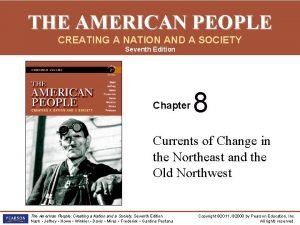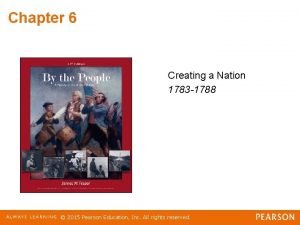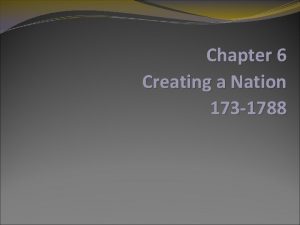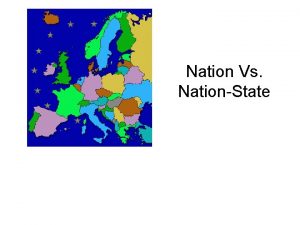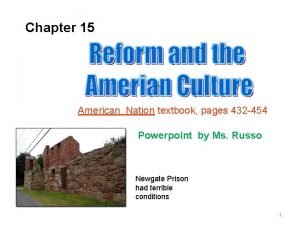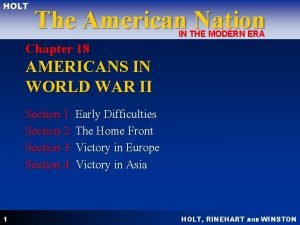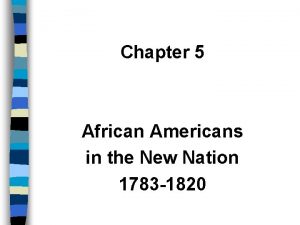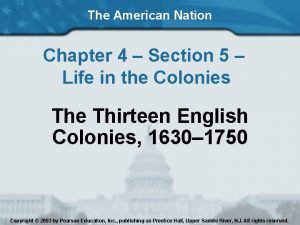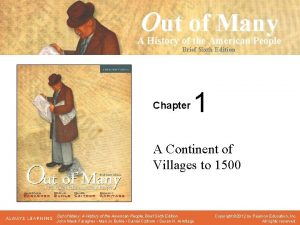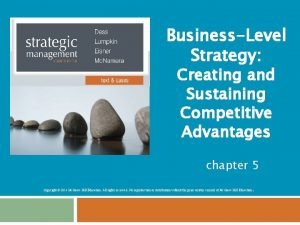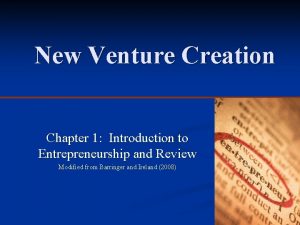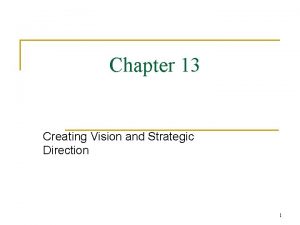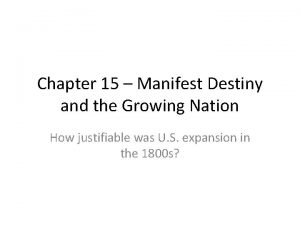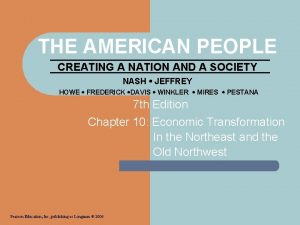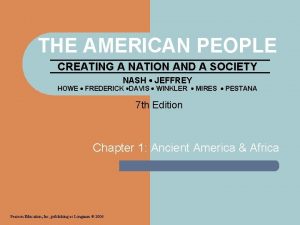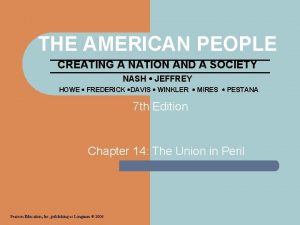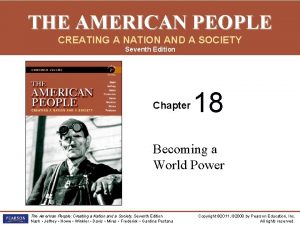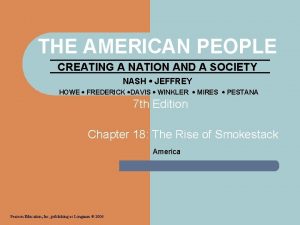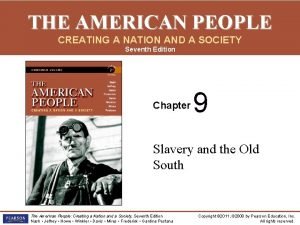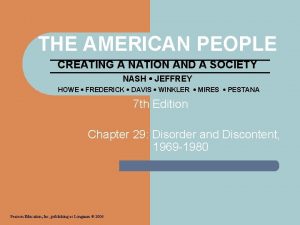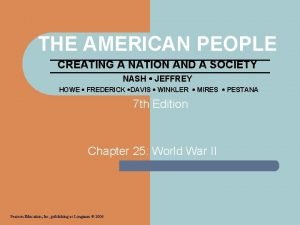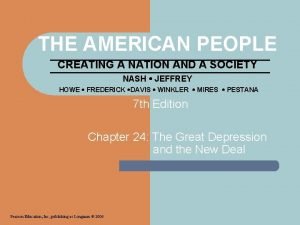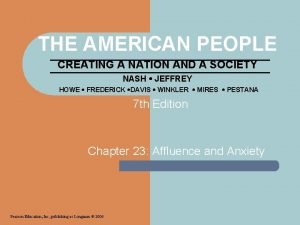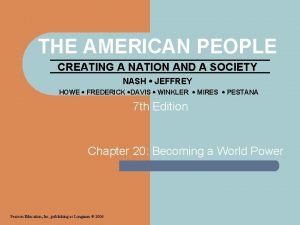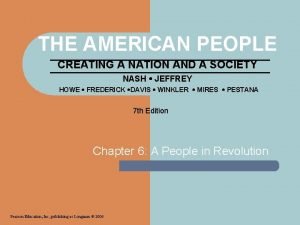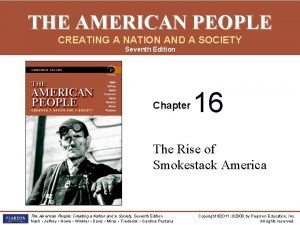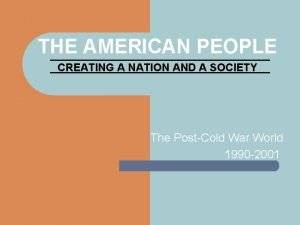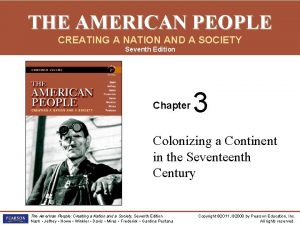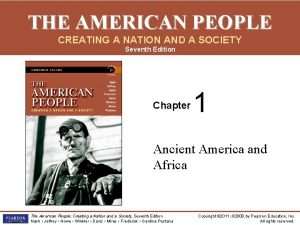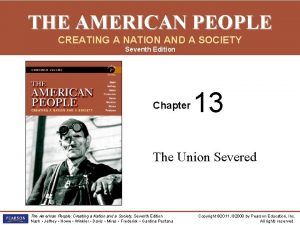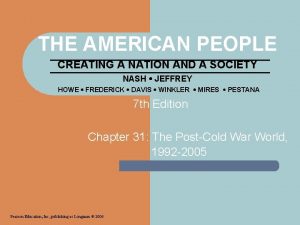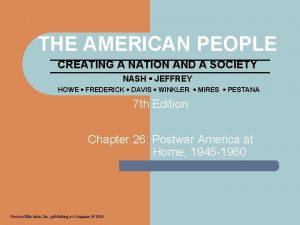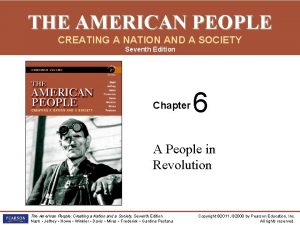THE AMERICAN PEOPLE CREATING A NATION AND A





















































































- Slides: 85

THE AMERICAN PEOPLE CREATING A NATION AND A SOCIETY NASH JEFFREY HOWE FREDERICK DAVIS WINKLER MIRES PESTANA 7 th Edition Chapter 4: The Maturing of Colonial Society Pearson Education, Inc, publishing as Longman © 2006

THE NORTH: A Land of Family Farms l l New England strove to maintain homogeneity by making immigrants unwelcome Mid-Atlantic colonies swarmed with immigrants from the Rhineland Ireland – – 90, 000 Germans (mostly in families) came in during eighteenth century fleeing famine, war and pestilence and settling where promoters promised cheap and fertile land, low taxes and no military service Even more Scots-Irish arrived, settling in New York, Pennsylvania, and the mountain valleys of the Carolinas and Georgia



NORTHERN AGRICULTURAL SOCIETY l l New England gradually saw a predominance of independent farming villages that utilized their unique collection of resources to produce a mixed economy of fishing, craft production based on timber, and traditional staple crops The middle colonies enjoyed better soil conditions than the north and usually produced a surplus of goods which were sold in the West Indies and Europe, strengthening their ties with the Atlantic basin

NORTHERN AGRICULTURAL SOCIETY l Northern society was distinguished by broad ownership of land – – l Differences in circumstances and ability led to greater social stratification though few were truly rich or abjectly poor Most men, with the exception of indentured servants, lived to purchase or inherit a farm of at least 50 acres from which they earned a decent living and provided for their children Freehold tenure ordinarily guaranteed both economic independence and political rights

NORTHERN AGRICULTURAL SOCIETY l By eighteenth century, the rising population pushed against a limited land supply, where 50 acres was the minimum for a working farm – l Caused many to head to frontier or leave area altogether – l Dwindling soil fertility Concord: starting in 1740 s, one out of four men migrated every decade Due to the less intense agricultural rhythm, many supplemented incomes with artisanal work

UNFREE LABOR l Northern colonies had less need for labor due to shorter growing seasons, though much of immigration after 1713 were indentured servants and slaves – – l Shipboard conditions for both worsened during the eighteenth century Indentured servants suffered a shipboard mortality rate of 15% Most indentured servants found the labor system harsh and the only real beneficiaries were the masters

UNFREE LABOR l The number of northern slaves also grew though not as fast as the number of indentured servants – l Slaves less than 10% of all northern populations and in most places only 3 -4% Northern conditions of slavery: – – Lived alone or with few other slaves in home of masters so adapted faster in North to European ways Slavery was less repressive Africans typically worked as artisans, farmhands or personal servants Slavery grew fastest in ports where artisans invested profitably in slaves, ships captains purchased them for maritime labor and elites displayed their wealth by buying slaves as coachmen and personal servants

UNFREE LABOR l By beginning of eighteenth century, more than 40% of New York City households owned slaves – l l Philadelphia: slaveholding increases sharply Struggling white artisans resented slave’s undercutting their wages and the white populace feared slave arsonists and rebels Slave seemed like bargain since got lifetime servant for cost of two years’ worth of a free white laborer’s wages

CHANGING VALUES l Expansive environment and Protestant emphasis on self-discipline and hard work bred ambitiousness, individualism, and materialism – – – l Religious intensity began to wane Colonists began to see life as not just preparation for the afterlife Land was increasingly viewed as a commodity The American ethics of hard work and materialism were highlighted in Ben Franklin’s Poor Richard’s Almanac, which was the most widely read book in the colonies after the Bible – – Captured spirit of rising secularism and preached utilitarian doctrine that good is whatever is useful Community best served through individual self-improvement and accomplishment

WOMEN AND THE FAMILY IN THE NORTHERN COLONIES l Women were viewed as subordinate and taught to be modest, patient and compliant – – – Were seen as weak of mind and large of heart Few women complained that work was limited to housewifery and midwifery Accepted exclusion from public schools, transfer of property or income to husbands at time of marriage and customs prohibiting them from speaking in churches or helping govern them (Quakers exception)

WOMEN AND THE FAMILY IN THE NORTHERN COLONIES l Marriage was a means of transferring property, not a vehicle for romance – – l Divorce almost impossible to obtain Women slowly gained right to consent to marriage partner While one in 10 European women did not marry, unmarried women in the colonies were almost unheard of – – Widows remarried with speed Woman and wife became synonymous

WOMEN AND THE FAMILY IN THE NORTHERN COLONIES l Single women and widows could make contracts, represent themselves in court, hold and convey property, and conduct business though these rights were forfeited upon marriage – – Colonial legislatures and courts gave wives more control over property brought into marriages or left at husband’s death Enjoyed broader rights to act for and with their husbands in business transactions

WOMEN AND THE FAMILY IN THE NORTHERN COLONIES l Women had limited career choices and rights but broad responsibilities and work spaces and daily routines frequently overlapped with those of their husbands – – Farm women and men worked at planting, harvesting and milking cows while women also made candles and soap, butter and cheese, smoked meat, made cloth and sometimes marketed their produce Merchants’ wives kept shop, handled accounts when husband was away and helped supervise servants and apprentices

WOMEN AND THE FAMILY IN THE NORTHERN COLONIES Women shaped the world around them l Older women modeled the behavior of young women, aided the needy and subtly affected menfolk l Women outnumbered men in church life and worked to promote religion in their families, to seat and unseat ministers to influence morals l Until late eighteenth century, child birth and surrounding issues was almost entirely in their hands – Between 20 and 40 years of age colonial women spent half their lives pregnant or nursing

WOMEN AND THE FAMILY IN THE NORTHERN COLONIES l English women typically married in their midtwenties but American women married earlier, increasing their childbearing years – – Average colonial family included 5 children (two others typically died in infancy) while English families contained fewer than three Gradually marriage increased and number of children decreased

WOMEN AND THE FAMILY IN THE NORTHERN COLONIES l Child-rearing patterns varied – – – l Puritan families were dominated by stern fathers who freely punished recalcitrant children in their goal of breaking the child’s will Quaker mothers used love rather than guilt to mold children Puritan parents usually arranged the marriages of their children though allowed them the right to veto Quaker men and women made their own matches, subject to parental veto All children contributed to the family economy Father-dominated family of New England was gradually replaced by mother-centered family, in which affectionate parents encouraged selfexpression and independence in their children

ECOLOGICAL TRANSFORMATION l The rabid demand for wood—building and heating homes, charcoal for ironmaking, shipbuilding and barrelmaking—quickly depleted the coastal forests of the colonies – – l Summers became hotter and winters colder Early melting snow caused watersheds to empty faster and triggered soil erosion and drought Livestock animals brought over from Europe devastated the ecosystems of America – – Grazing animals devoured best plant species and new, unwelcome species took over Native grasses and shrubs disappeared quickly and European livestock began to die for lack of grazing land

ECOLOGICAL TRANSFORMATION l Native animals—beaver, deer, bear, wolf, raccoon, and marten—became extinct as they were killed for fur or eliminated as predators – l Animals, like turkeys, that were prized as food also became rarer Europeans did not see the ecosystem as a series of interconnected elements ripe for exploitation – Produced wasteful practices

THE PLANTATION SOUTH l l l 1690 -1760: Southern white tidewater settlements changed from a frontier society with high immigration, a surplus of males, and an unstable social organization to a settled society composed mostly of native-born families After 1715 Scots-Irish and German immigrants flooded into the backcountry of Virginia, the Carolinas, and the new colony of Georgia which was founded in 1732 as a debtors’ haven and buffer between Spanish Florida and the Carolinas Fast growing slave population accounted for swifter population growth than in the North – Virginia, with population of 340, 000 by 1760, was largest colony

THE TOBACCO COAST l Tobacco production in Virginia and Maryland reached 25 million pounds annually during the 1680 s – – Two decades of war in Europe made commercial traffic more dangerous, drove up transportation costs, and dampened tobacco demand Stagnations lasted from mid-1680 s to 1715 Social transformation in Upper South l African slaves replaced indentured servants by 1730 l Planters diversified crops and sought to become more self-sufficient l African slaves went from 7 to more than 40% of population between 1690 and 1750 and gender imbalance disappeared – Families predominated

THE TOBACCO COAST l In 1750, a majority of families owned no slaves and not more than one-tenth of slaveholders held more than 20 slaves – l Common goal was to own a plantation with slaves Big planters created gentry lifestyle marked by ritual display of wealth – – Racing thorough bred horses and gambling Construction of brick Georgian mansions filled with imported furniture and with formal gardens and orchards

THE TOBACCO COAST l Planter elite controlled the county courts, officered the local militia, ruled the parish vestries of the Anglican church, made law in legislative assemblies and passed control to their sons – – – l Were agrarian businessmen Tobacco cultivation required yearround attention Planter’s reputation rested on quality of crop Planters’ wives superintended cloth production and processing and preparation of food

THE RICE COAST l Rice and indigo were the staples of the plantation economy of the lower south in the eighteenth century – – – l Rice production around Charleston led to importation of thousands of slaves – – l l More than 1. 5 million pounds of rice per year in 1710 More than 80 million pounds by 1770 s Indigo became a staple crop in 1740 s and had spread into Georgia within a generation 1740: slaves composed 90% of inhabitants Wealthy planters entrusted plantations to overseers and wintered in Charleston and summered in Newport, Rhode Island Courthouse served as male gathering place throughout South Church, almost always Anglican before 1750, was a community center


THE BACKCOUNTRY l As late as 1730, only hunters and Native American fur traders ventured into upland backcountry from Pennsylvania to Georgia – – Over next four decades, attracted 250, 000 settlers, nearly half the southern white population Settlers were predominantly German and Scots-Irish who built a subsistence society of small farms Remained isolated from coastal region leading to persistence of folkways For a generation, endured poor diet, endless work and meager rewards

THE BACKCOUNTRY l By 1760 s backcountry began to emerge from frontier stage – – Marketing towns became centers of craft activity, church life and local government Farms began producing surpluses for shipment east Density of settlement increased, creating a social life Class distinctions remained narrow

FAMILY LIFE IN THE SOUTH l Male and female roles became more physically and functionally separated – – l Planters’ sons had always been trained in horsemanship, the use of a gun, and the rhythms of agricultural life – – l White gender ratio neared parity by 1720 s, depriving women of leverage in the marriage market Growth of slavery made wealthy planter’s wife into domestic manager of plantation home Learned how to manage and discipline slaves Developed self-confidence and authority that led many into leadership roles during Revolution On small farms, women’s roles resembled those of northern women and family life and marriage were more informal in the backcountry

ENSLAVED AFRICANS IN THE SOUTHERN COLONIES l A continued growth in the slave trade and natural reproduction during the seventeenth century saw the population ratio of Africans in America grow to onefifth – – – l 1690: 15, 000 slaves 1730: 80, 000 slaves 1760: 325, 000 slaves Averaging about 5000 a year from 1700 to 1775, more than 350, 000 Africans entered the colonies during that period – Most were sold to southern planters though some wound up in northern cities


ENSLAVED AFRICANS IN THE SOUTHERN COLONIES l Masters hoped to convert slaves into mindless drudges but really could only set the external boundaries of existence of their slaves – – l Controlled physical location, work roles, diets, and shelter Impinged less on how slaves established friendships, fell in love, formed kin groups, reared children, worshipped their gods, buried their dead and organized their leisure time Slaves drew on African heritage to shape existence to some degree, helping create and African American culture

ENSLAVED AFRICANS IN THE SOUTHERN COLONIES l Relatively healthy environment of North America meant slaves had a much better chance of survival – l Combined with more equal gender ratio, led to natural increase in numbers unparalleled elsewhere While slave codes restricted lives of slaves, chances for marriage did increase as colonies matured – By 1740 s, a growing proportion of Chesapeake slaves were American born, had established families and lived in plantation outbuildings

ENSLAVED AFRICANS IN THE SOUTHERN COLONIES l In South Carolina, African slaves were vital to making rice a keystone of economy – – l Population increased from 4000 in 1708 to 90, 000 by 1760 Endured most life sapping conditions on continent Low number of whites meant they could maintain more of their African culture than Chesapeake slaves – – Many spoke Gullah Gave African names to their children and kept alive African religious customs

RESISTANCE AND REBELLION l Slaveowners interpreted rebelliousness as evidence of “barbarous, wild savage natures” of Africans – l Resisters’ goals varied: – – l To Africans, resistance was essential to maintaining meaning and dignity Rejoining family members Flee Persuade masters to improve their condition Avenge sadistic overseers Africans fresh from Africa often resisted fiercely, usually by fleeing – To renegade frontier settlements, interior Native American communities or Spanish Florida

RESISTANCE AND REBELLION l Rebellions, such as the ones in New York City in 1712 and in Stono, Virginia, in 1739, mostly involved newly arrived Africans – – l No North American parallel to the massive uprisings in Brazil and the West Indies Relatively small rebellions that did occur led to atrocious repression As slaves learned English, adjusted to work routines and formed families, shifted to more subtle resistance – – Dragging out jobs, pretending illness or ignorance, breaking tools Truancy, arson, crop destruction, pilfering, direct assaults were more direct ways to express dissatisfaction

BLACK RELIGION AND FAMILY l l l Religion and family served as bulwarks for slaves against massively repressive system In mid-eighteenth century, slaves began to blend Christianity and African religious traditions Religious revival of 1720 s, which spread from the North, made important contributions to African American religion – l Evangelicalism stressed personal rebirth, used music and body motion, and produced an intense emotional experience While most colonies prohibited marriage, most slaves and masters reached a compromise because slaves wanted families and masters found that they worked better with them

BLACK RELIGION AND FAMILY l General practice of importing 3 male slaves for every 2 female slaves stunted family growth – – – l l Female slaves married in their late teens Male slaves usually had to wait to mid- to late twenties Natural increase made gender ratio more even during eighteenth century Slave marriages were insecure Children usually stayed with their mother until age 8, when they were frequently sold

BLACK RELIGION AND FAMILY l White male exploitation of female slaves was another assault on family life – – – In some instances coercion was subtle Sometimes black women sought relations to gain advantages What ever the reason, unions threatened both slave community and white plantation ideal by bridging supposedly unbridgeable gap and producing children who did not fit into racial categories

BLACK RELIGION AND FAMILY l While slave men struggled to preserve their family role, many slave women assumed roles different than that of white counterparts – – l Black women worked in both the field and the house. Constant labor made them more equal to men than white women Slavery was a set of power relations aimed at extracting maximum labor but North American slaves toiled less, were better clothed and fed and generally better treated than slaves in other parts of the hemisphere

CONTENDING FOR A CONTINENT l 1750: colonists numbered 1. 2 million colonists, majority living within 100 miles of Atlantic coast – l Challenged by French in interior and Spanish to south On West coast, Spanish were moving up coast of California until they reached the limits of Russian settlement in northern California

FRANCE’S INLAND EMPIRE l Louis XIV saw New France as aid to building most powerful nation in Europe – – – l Timber would build navy Fish would feed slaves in Caribbean Fur trade would fill royal coffers New France grew in population, economic strength and ambition – – – 1673: Louis Joliet and father Jacques Marquette explored territory watered by the Mississippi and Missouri rivers 1680 s: military engineers and priests built forts and missions in Great Lakes region and Mississippi valley 1682: René Robert La Salle canoed down the Mississippi to Gulf of Mexico and planted a settlement at Matagorda Bay in Texas 1699: Pierre Moyne d’Iberville established settlement at Biloxi 1702: d’Iberville established settlement at Mobile

FRANCE’S INLAND EMPIRE l French growth threatened to pin the English to the seaboard – – – French success hinged on shrewd dealing with Native Americans who retained sovereignty over the land but gradually succumbed to French diseases, French arms and French-promoted intertribal wars French settlers were predominantly male and often married Indian women, producing metissage and cementing trade and military alliances By 1750, population of 70, 000 was mixed-race

French North America, 16081763

FRANCE’S INLAND EMPIRE l 1718: France settled New Orleans. – – – l French slaves were vital to development of Louisiana – – – l Transported 7000 whites and 5000 African slaves Disease quickly reduced numbers 1729 uprising by Natchez Indians discouraged further settlement Had skills as rice growers, indigo processors, metal workers, river navigators, herbalists and cattle keepers Male slaves mingled extensively with Native American women (mixed offspring known as grifs) African women often had liaisons with French men 1765: with blacks outnumbering whites, they often served as militiamen, and sometimes received freedom for military service Chance of gaining freedom greater than in any other colony as was absorption into white society of free blacks 1769: Spanish took over colony and guaranteed slaves the right to buy freedom with money earned in free time


A GENERATION OF WAR l l Protestant New Englanders viewed Catholic New France as a satanic challenge European wars began in 1689 as a result of Louis XIV’s aggression in Europe – l 1689 -1697 (King William’s War) and 1701 -1713 (Queen Anne’s War) French and English expanded their European fighting to North America English struck three times at Port Royal – – 1690: captured Port Royal though returned to French at end of war During Queen Anne’s War, New England attacked three times before capturing in 1710

A GENERATION OF WAR l Land sea operations were often unsuccessful in New World so both sides turned to Indian allies – – l French and Native American allies wiped out Schenectady, New York, in 1690; Wells, Maine, and Deerfield, Massachusetts, in 1703; and continually menaced the frontier English supplied Iroquois assaulted French settlements in first war but stayed out of second English triumphed in both wars but losses in New England were severe – – – One-fifth of all able-bodied men participated in Canadian campaigns and about one-quarter of these never returned. Massachusetts had a war debt of £ 50, 000 In 1713, war widows were so common that Bay Colony faced its first serious poverty problem

Queen Anne’s War Battle and Territorial Changes

A GENERATION OF WAR l War at sea affected colonies south of New England who stayed out of land war – – l l New York lost one of best grain markets French Navy plucked off nearly one-quarter of port’s fleet and disrupted Philadelphia’s access to Caribbean The wars caused some poor men to rise spectacularly and the rich to gain in wealth, but for most men it was a disaster financially 1713: Treaty of Utrecht gave England Newfoundland Acadia and France recognized English sovereignty in Hudson Bay territory while retaining Cape Breton Island – – – In Caribbean, France yielded Kt. Kitts and Nevis to England Spain lost provinces in Italy and last holdings in Netherlands to Austrians and Gibraltar and Minorca to the English also won right to supply Spanish America with slaves

SPAIN’S FRAIL NORTH AMERICAN GRIP l l Spanish lost control of Florida Indians, who had been hurt by South Carolinian sponsored slave raid, to British and French trade goods Spanish settlements, regarded as marginal, money-losing affairs that were only useful as defensive outposts, stagnated in first half of eighteenth century – – l New Mexico had a population of 10, 000 at mid-century Racial mixture and social fluidity more prevalent than in English colonies Southwestern Indians maintained a certain autonomy but California Indians were less successful after Spanish extended control in 1770 s from San Diego to Yerba Buena (San Francisco) – Franciscan missionaries attracted Native Americans and then held them in conditions that approached slavery


CULTURAL AND ECOLOGICAL CHANGES AMONG INTERIOR TRIBES l l During first half of eighteenth century, inland tribes managed to adapt and maintain their independence European trade goods—especially iron implements, textiles, firearms and ammunition, and alcohol—altered Native American lifestyles – – – l Subsistence hunting became commercial hunting Men spent more time away from villages in search of prey Commercial activities sometimes became so time consuming, food had to be purchased from other tribes Spiritual beliefs that destinies of animals and humans were linked eroded Competition for fur increased intertribal conflict while European weapons made these conflicts more deadly Loose confederations adapted more centralized leadership as a result of trade, diplomatic contact and war

THE URBAN WORLD OF COMMERCE AND IDEAS l Only 5% of eighteenth century colonists lived in towns as large as 2500 people – l No city had more than 16, 000 people in 1750 or 30, 000 in 1775 Urban societies were on the cutting edge of transition to “modern” life – – – Barter economy gave way to commercial economy Social order based on assigned status gave way to one based on achievement Rank-conscious, deferential politics changed to participatory and contentious politics Small scale artisanship was replaced by factory production. European ideas radiated out to hinterland


SINEWS OF TRADE l For 50 years after 1690, Boston, New York, Philadelphia and Charlestown became thriving commercial centers connected to developing agricultural interiors – – – l By eighteenth century, American economy was integrated into Atlantic trading system – l As colonial population rose and spread out, minor seaports gathered 5000 or more inhabitants Cities served as trade centers Merchants were pivotal figures Britain pursued mercantalist beliefs in increasing exports, taxing imports, regulating production and trade and exploiting colonies Americans earned credits they need for their imports by selling food and timber to the West Indies and providing shipping and distribution services

THE ARTISAN’S WORLD l Merchants were first in wealth and prestige but artisans were more numerous – – l l Two-thirds of adult males labored at handicrafts and specialization expanded with growth of cities. Work patterns were irregular Striving for respectability, artisans placed a premium on achieving economic independence During good times, artisans expected to make a “decent competency” and purchase a small house but these expectations were often affected by a variety of factors

URBAN SOCIAL STRUCTURE l Population growth, economic development and war altered urban social structure between 1690 and 1765 – l Poverty, as well as wealth, began to appear and was especially prevalent after 1720 – l Stately townhouses displayed newly acquired fortunes Cities devised new ways of helping the needy Gaps between the wealthy and the poor began to widen – – Top 5% of tax payers increased share of assets from 30 to 50% between 1690 and 1770 Bottom half saw their share shrink from 10 to 4%


THE ENTREPRENEURIAL ETHOS l Traditional views said economic life should operate according to what was fair, not what was profitable – – l Regulated prices and wages, quality controls, supervised public markets, and other measures were seen as natural Community was defined as a single body of interrelated parts New views said prosperity required the encouragement of acquisitive appetites because that would encourage economic activity as more people sought more goods – If people were allowed to pursue their material desires competitively, they would collectively form a natural, impersonal market of producers and consumers that would advantage everyone

THE ENTREPRENEURIAL ETHOS l Merchants began to make decisions according to emerging commercial ethic that responded only to the laws of supply and demand – Tension between old and new visions erupted during food shortages and galloping inflation which usually occurred only during war


THE AMERICAN ENLIGHTENMENT l European thinkers supported optimistic notion that a benevolent God had blessed humankind with supreme gift of reason – – l Locke: God had not predetermined content of human mind but had provided ability to gain knowledge Acquisition of knowledge prized because allowed humans to improve their condition Scientific knowledge could improve society – – Belief in natural law Debate about natural human rights

THE AMERICAN ENLIGHTENMENT l Ideas about rights expressed by Diderot found expression in reform movements such as those focused against slavery – – Idea grew that it contradicted Christian concept of brotherhood and Enlightenment notion of natural equality or all people Growing belief that a slave master’s authority “depraved the mind”

THE AMERICAN ENLIGHTENMENT l Americans began to make significant contributions to advancement of science – – – John Bartram and other naturalists gathered and described American plants John Winthrop III made accurate measure of earth’s distance from the sun Benjamin Franklin and his experiments with electricity

THE AMERICAN ENLIGHTENMENT l Franklin’s true genius was in practical application of knowledge – – – Lightening rod Cost-effective stove Bi-focal spectacles Founded first circulating library in 1731 Founded artisans’ debating club for “mutual improvement” and an intercolonial scientific association that became American Philosophical Society

THE GREAT AWAKENING l l Timing and character varied from region to region Quest for spiritual renewal that challenged old sources of authority and produced patters of thought and behavior that fueled a revolutionary movement in the next generation

FADING FAITH l Early eighteenth century British America was overwhelmingly Protestant – – – l l l New England (except Rhode Island) was Congregationalist) New York and most of South except backcountry was Anglican Mid-Atlantic and backcountry settlements contained German Mennonites, Dunkers, Moravians and Lutherans; Scots-Irish Presbyterians; and English Baptists and Quakers Two-thirds of colonists went to no church, partly because they were unavailable in some places Most colonial churches were voluntary groups Clergy often administered congregations with difficulty

FADING FAITH l Apathy became a growing problem – 1660: New England’s Congregational Church adopted the Half-Way Covenant which allowed children of church members, if they adhered to “forms of godliness, ” to join the church even if could not demonstrate had undergone conversion experience l – Could not vote in church affairs or take communion Educated clergy appealed to minds but not hearts

THE AWAKENERS’ MESSAGE l Great Awakening was a series of revivals that swept the colonies from 1720 to 1760 – – – l 1720 s: New Jersey and Dutch Reformed minister Theodore Freylinghuysen and Presbyterian Gilbert Tennent 1730 s: Pennsylvania and Presbyterians and Connecticut River valley where Jonathan Edwards emerged as leader 1739: British Anglican priest George Whitefield barnstormed through colonies seven times Appeal of Awakeners lay in appeal to emotion and individual participation through “lay exhorting”

REVIVALISM IN THE URBAN NORTH l Religious zeal in the North became worrisome to the wealthy elite as their position in society was questioned by the Awakeners

SOUTHERN REVIVALISM l Great Awakening hit South in 1740 s even as ebbed in the North – – l The South also saw a rejection of the assumed authority of the landed gentry as a ruling class – l 1750 s: New Light Presbyterianism 1760 s: Baptists Appealed to poor and to slaves In both regions, religion weakened the cultural authority of the upper class and produced a vision of a society drawn on more equal lines

LEGACY OF THE AWAKENING l l l Promoted religious pluralism and idea that all denominations were equally legitimate thereby encouraging religious harmony. An emerging tradition of separation of church and state Legitimized religious and social diversity within local communities – l Before 1740 only Puritan Harvard (1636) and Yale (1701) and Anglican William and Mary (1693) but now six new colleges— Dartmouth, Brown, Princeton, Columbia, Rutgers and University of Pennsylvania—all without religious connections Fostered changes in political and moral views – – – New feelings of self-worth Skepticism regarding dogma and authority Concern over growing materialism and acceptance of self-interested behavior

POLITICAL LIFE How should political power be divided: l Within England? l Between the English government and the colonies? l Within each colony?

STRUCTURING COLONIAL GOVERNMENTS l In place of absolute monarchy, English believed in balance of monarchy, aristocracy and democracy – l l Alone each would degenerate into oppression Colonies developed a system of government based on the authority of a governor or agent of the king (monarchy) supplemented by bicameral legislatures with an upper house of mainly appointed wealthy men (aristocracy) and a lower house of locally elected representatives (democracy) Every statute required governor’s assent (except in Rhode Island Connecticut) and all colonial laws required approval from the king’s privy council

STRUCTURING COLONIAL GOVERNMENTS l In England ownership conferred political rights – – – l Colonists (with exception of Massachusetts which had religious requirement until 1691) generally followed this rule 40 shilling freehold requirement allowed 50 to 75% of adult free males to vote As proportion of landless increased in eighteenth century, franchise contracted Notion that powerful and wealthy should hold main political positions balanced by belief that entire electorate should periodically judge their performance


THE CROWD IN ACTION l A general lack of police power gave import to public demonstrations against unpopular laws and set an American precedent of popular dissent – – l In country only sheriff In town, sheriff and night watch Impressment Riot in Boston in 1747

THE GROWING POWER OF THE ASSEMBLIES l In seventeenth century, governors were more powerful than legislatures – – – – Could dissolve lower houses and delay their sitting. Could control election of speaker Could initiate legislation without legislature. Had authority to appoint and dismiss judges and create chancery courts Controlled expenditure of public monies Could grant land to individuals and groups Lacked patronage powers

THE GROWING POWER OF THE ASSEMBLIES l l In eighteenth century, New Jersey (1702), South Carolina (1719) and North Carolina (1729) joined Virginia, Massachusetts and New York as royal colonies Eighteenth century the power of legislatures increased as they won new rights: – – – To initiate legislation To elect their own speaker To settle contested elections To discipline members To nominate provincial treasurers To initiate money bills, specifying how much should be raided and how it should be spent

LOCAL POLITICS l Binding elected office holders to their constituents became an important feature of colonial political system – l Many lower house members were merchants, lawyers, and substantial planters and farmer Local government was usually more important to colonists than provincial government – – North: political authority rested in town South: primary unit of government was county dominated by landed squirearchy

THE SPREAD OF WHIG IDEOLOGY l Whig, or “republican, ” ideology had spread by mid-eighteenth century – – Rested on belief that concentrated power was the enemy of liberty and that too much power lodged in one person or group produced corruption and tyranny Best defense was balanced government, elected legislatures who checked executive authority, prohibition of standing armies and vigilance of the people

THE SPREAD OF WHIG IDEOLOGY l Ideology reached people through 23 colonial newspapers – l Because papers passed from hand to hand were read aloud, probably reached more people than mere subscription numbers suggest Zenger Case, New York: John Peter Zenger, hired by anti-government faction to start paper in 1733 – – – Arrested for seditious libel Lawyer, Alexander Hamilton, sought to convince jury Zenger was merely providing information regarding attacks on their liberties Jury acquitted Zenger but libel laws remained restrictive


DISCOVERING U. S. HISTORY ONLINE History Buff’s Reference Library http: //www. historybuff. com/library/refseventeen. html l Bethlehem, Pennsylvania http: //bdhp. moravian. edu/home. html l Martha Ballard’s Diary http: //www. dohistory. org/ l
 The american people creating a nation and a society
The american people creating a nation and a society Creating a new nation
Creating a new nation Chapter 6 creating a nation
Chapter 6 creating a nation Chapter 6 creating a nation
Chapter 6 creating a nation State vs nation
State vs nation Country vs nation
Country vs nation Nation state vs nation
Nation state vs nation The american nation textbook answers
The american nation textbook answers Holt american nation
Holt american nation Chapter 5 african american in the new nation
Chapter 5 african american in the new nation American nation chapter 4
American nation chapter 4 American nation chapter 4
American nation chapter 4 Folk nation
Folk nation Native mob gang
Native mob gang Spanish gangster disciples colors
Spanish gangster disciples colors Two types of people media are
Two types of people media are Where is the love black eyed peas lyrics
Where is the love black eyed peas lyrics Creating and interpreting graphs and tables
Creating and interpreting graphs and tables Hình ảnh bộ gõ cơ thể búng tay
Hình ảnh bộ gõ cơ thể búng tay Bổ thể
Bổ thể Tỉ lệ cơ thể trẻ em
Tỉ lệ cơ thể trẻ em Chó sói
Chó sói Chụp tư thế worms-breton
Chụp tư thế worms-breton Chúa yêu trần thế alleluia
Chúa yêu trần thế alleluia Kể tên các môn thể thao
Kể tên các môn thể thao Thế nào là hệ số cao nhất
Thế nào là hệ số cao nhất Các châu lục và đại dương trên thế giới
Các châu lục và đại dương trên thế giới Công thức tính thế năng
Công thức tính thế năng Trời xanh đây là của chúng ta thể thơ
Trời xanh đây là của chúng ta thể thơ Cách giải mật thư tọa độ
Cách giải mật thư tọa độ 101012 bằng
101012 bằng độ dài liên kết
độ dài liên kết Các châu lục và đại dương trên thế giới
Các châu lục và đại dương trên thế giới Thể thơ truyền thống
Thể thơ truyền thống Quá trình desamine hóa có thể tạo ra
Quá trình desamine hóa có thể tạo ra Một số thể thơ truyền thống
Một số thể thơ truyền thống Cái miệng nó xinh thế chỉ nói điều hay thôi
Cái miệng nó xinh thế chỉ nói điều hay thôi Vẽ hình chiếu vuông góc của vật thể sau
Vẽ hình chiếu vuông góc của vật thể sau Nguyên nhân của sự mỏi cơ sinh 8
Nguyên nhân của sự mỏi cơ sinh 8 đặc điểm cơ thể của người tối cổ
đặc điểm cơ thể của người tối cổ Thế nào là giọng cùng tên
Thế nào là giọng cùng tên Vẽ hình chiếu đứng bằng cạnh của vật thể
Vẽ hình chiếu đứng bằng cạnh của vật thể Vẽ hình chiếu vuông góc của vật thể sau
Vẽ hình chiếu vuông góc của vật thể sau Thẻ vin
Thẻ vin đại từ thay thế
đại từ thay thế điện thế nghỉ
điện thế nghỉ Tư thế ngồi viết
Tư thế ngồi viết Diễn thế sinh thái là
Diễn thế sinh thái là Dot
Dot Số nguyên tố là số gì
Số nguyên tố là số gì Tư thế ngồi viết
Tư thế ngồi viết Lời thề hippocrates
Lời thề hippocrates Thiếu nhi thế giới liên hoan
Thiếu nhi thế giới liên hoan ưu thế lai là gì
ưu thế lai là gì Hươu thường đẻ mỗi lứa mấy con
Hươu thường đẻ mỗi lứa mấy con Khi nào hổ mẹ dạy hổ con săn mồi
Khi nào hổ mẹ dạy hổ con săn mồi Hệ hô hấp
Hệ hô hấp Từ ngữ thể hiện lòng nhân hậu
Từ ngữ thể hiện lòng nhân hậu Thế nào là mạng điện lắp đặt kiểu nổi
Thế nào là mạng điện lắp đặt kiểu nổi Out of many a history of the american people
Out of many a history of the american people Chapter 8 section 1 latin american peoples win independence
Chapter 8 section 1 latin american peoples win independence Recovery community
Recovery community Justpeople
Justpeople Creating production possibilities schedules and curves
Creating production possibilities schedules and curves Chapter 1 marketing
Chapter 1 marketing Creating and sustaining competitive advantage
Creating and sustaining competitive advantage What are customer value satisfaction and loyalty
What are customer value satisfaction and loyalty Creating customer value satisfaction and loyalty
Creating customer value satisfaction and loyalty Inner critic and inner defender
Inner critic and inner defender Creating and starting the venture
Creating and starting the venture Vision focuses on the current reality and maintaining it
Vision focuses on the current reality and maintaining it 2-2 creating and solving equations
2-2 creating and solving equations Creating and capturing customer value
Creating and capturing customer value Creating and capturing customer value
Creating and capturing customer value Creating customer value satisfaction and loyalty
Creating customer value satisfaction and loyalty Excel module 1: creating a worksheet and a chart
Excel module 1: creating a worksheet and a chart Marketing creating and capturing customer value
Marketing creating and capturing customer value Creating and interpreting distance time graph
Creating and interpreting distance time graph Creating and interpreting distance time graph
Creating and interpreting distance time graph Capturing value from customers
Capturing value from customers Loyalty and devotion towards a nation.
Loyalty and devotion towards a nation. Every nation and every country
Every nation and every country Every nation has its own
Every nation has its own Chapter 15 manifest destiny and the growing nation
Chapter 15 manifest destiny and the growing nation A new nation and its growing pains
A new nation and its growing pains
